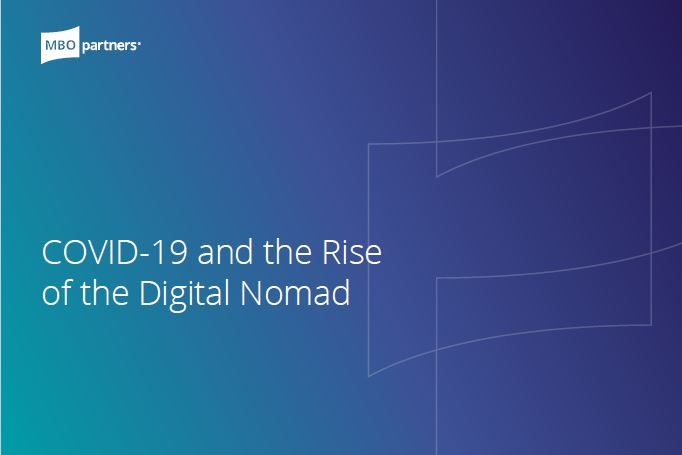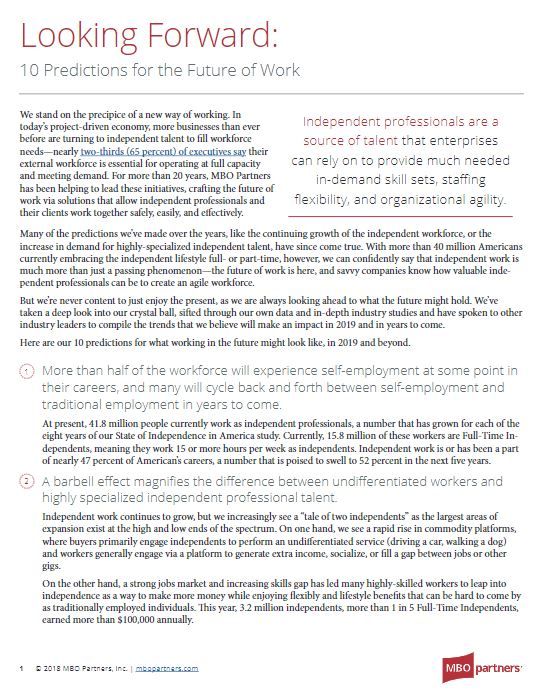Future of Work
10 Future of Work Trends and Predictions
2020 was a year that had us rethinking our approach to everything - and rethinking work was top of the list for many, given the sudden and dramatic move to remote work and the impact of the pandemic on society.
In the midst of this year, MBO continued its annual tradition of studying the future of work, launching its much-awaited 11th annual State of Independence in America survey.
Here's our countdown of the top 10 predictions we believe will drive the future, post pandemic.
10: Growth of Independent Work - Despite a Covid Dip
A short-term disruption due to COVID-19 was acute for both independents and the economy overall. Not surprisingly, the number of working independents fell 7 percent from 2019 to 2020, to 38.2 million in 2020 from 41.1 million in 2019. However, despite this dip, we're projecting that independent work will continue to grow and more than 50% of Americans will spend time serving in an independent career in the next ten years.
9: A Rise in Happiness - For Some
The outlook is grim when it comes to happiness and satisfaction for traditional careers. However, independents ironically say they feel more secure than traditional workers - with 56% saying this path is more secure, another reason we're predicting more workers will experience and stick with an independent career path. 7 in 10 independents already say they will continue working solo. We're voting that careers that provide greater happiness will be more likely to attract workers, especially younger Gen Z workers.
8: Gen Z Powers Solo & Micro Entrepreneurship
Gen Z already represents 16% of independent work, and given the demographic traits of this cohort, we believe they will power a growth in solo entrepreneurship. As this generation acquires marketable skills, they will use tech tools and platforms to find work and build careers powered by businesses of one.
7: Putting Control in the Worker's Hands
Providing workers autonomy and control over all aspects of their career from work style to work space will be a key trend that we predict for the next decade. Companies that can personalize career journeys and enable autonomy over career growth paths will succeed. Just look at independents - 76% of them are satisfied, despite the challenges of being solo. It's because they value the control to design their life in a way that allows them to do the work they love the way they want.
6: Exporting Intelligence - One Worker at a Time
While the last decade was about offshoring labor, we predict the next decade will include the reverse. Talented US workers will find ways to deliver work outcomes in any country and deliver borderless growth, enabled by new work platforms that connect buyers and providers. Independent work provides a data-driven clue: today, a staggering 28% are already providing goods and services outside the U.S.
5: The 80/20 Rule: High Earning Independents will Drive the Greatest GDP Impact
7.7 million independents already offer services and have built careers generating more than $100,000 in annual income, making them a part of the new American Dream of solo entrepreneurship. We predict much of the economic impact of the growth of non-traditional work will come from high-earning independent professionals who are charting a new career. As they blaze the path and deliver GDP impact, others will be inspired and follow.
4: The Side Hustle is the New Accessory
Those who are savvy about career and life in the next decade will automatically design a side hustle, complete with its own entity. Not only does this provide work income diversification in an insecure economy, it also provides the happiness and satisfaction workers crave. Today, 15% of independent workers are side-giggers. With the rise in the ability to productize services and knowledge, we think that number will grow.
3: The Team is the New Company - The Rise of Virtual Organizations
Before, to build a larger business, an office, a staff and a payroll was needed. With the advent of new work platforms that enable real-time teaming between independents, we're predicting a rise in the virtual, just-in-time organization - where talented individuals come together to deliver work and then disband until the next project arrangement. They maintain more control and flexibility, lower margins and raise efficiencies and satisfy their client's needs for great results. With teaming on the rise (20% did so in 2020), we think that it's only a matter of time before virtual reality is surpassed by virtual corporations.
The Rise of the Digital Nomad
Read our report on how working from anywhere has become the new passport to happiness.
2: Remote Work Powers The Future
One of the most important trends of 2020, that will transform the next decade of how we work, is the rise of remote work. 85% of independents worked remotely at least part of the time and nearly 40% were full time remote, even before the pandemic. As Zoom changes how we interact both locally and globally, we believe that remote work is here to stay, but that a desire to network will lead to a continued role for flexible working spaces, like coworking, or hybrid offices.
1: Independence as the New American Dream & A Related Workforce Transformation
As of 2020, 48 percent of the U.S. private workforce had worked independently at some point in their careers. By 2025, the number should reach 54 percent, a rate of more than 3 times the growth of employment. This statistic, coupled with the increased in generational shift and worker desire for autonomy, flexibility and control leads us to predict that the next decade of work will include independents work as a core part of any worker's portfolio, and a gradual increase in high-impact work being delivered by independent firms of one or a handful of talented professionals. These firms will transform the US small business landscape forever and leave an indelible mark on corporate America. As more workers go solo, companies will shift their engagement models to a variable, agile model - leading to a new workforce reality that requires a different set of human resources, talent management, payment and insurance solutions. The companies that quickly optimize labor models to address this will win in the marketplace.


